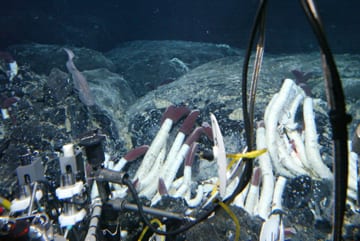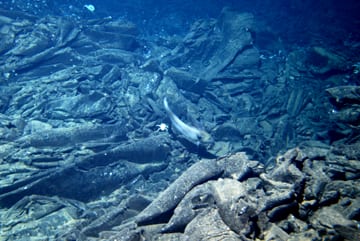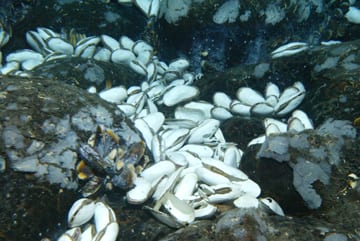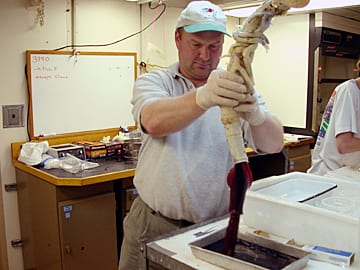New Hydrothermal Vent Sites Found, Original Vent May Have been Covered by Volcanic Eruption
June 4, 2002
The “Rose Garden” – one of the most well-visited and lush communities of seafloor vent life – may have been paved over by a recent volcanic eruption. But scientists on a just-completed expedition near the Galápagos Islands have discovered a thriving new community of very young tubeworms, clams, and mussels, which they have called “Rosebud.”
The 12-day expedition to the Galápagos Rift, where hydrothermal vents were first discovered 25 years ago, also found another new vent community in a previously unexplored region of the rift. This still-unnamed site was overflowing with clams up to 10 inches long and mussels nearly as large.
The expedition had sought to revisit “Rose Garden,” which had become an icon for deep-sea biologists. First found in 1979, it was filled with red-tipped tubeworms peeking out of 6-foot tall white tubes that swayed in shimmering warm vent fluids like flowers in the wind. Scientists had revisited the site in 1985, 1988, and 1990, and observed how mussels and clams had begun to overrun the tubeworm population. They had hoped to extend the longest-running investigation of how vent communities evolve over time, and how different vent animals move in and interact with each other.
But the expedition, which began May 24, found no signs of “Rose Garden,” nor any signs of previous visits. Instead scientists found a field of apparently fresh lava and a new community of very young clams, mussels and tubeworms as small as 1-inch in length.
The expedition was funded by the National Oceanic and Atmospheric Administration’s new Ocean Exploration Program, the National Science Foundation, and Woods Hole Oceanographic Institution. It was launched from the Research Vessel Atlantis, using a variety of deep-sea exploration instruments: Alvin, the human-occupied submersible; ABE, or Autonomous Benthic Explorer; a deep-sea towed camera system, and a towed CTD, which measures the conductivity, temperature and density of the water.
“This is what the Ocean Exploration Program is all about,” said Steve Hammond, Chief Scientist of NOAA’s OE program and Co-Chief Scientist of the expedition. “We’ve assembled and coordinated an excellent team of scientists and an arsenal of tools to explore and make new discoveries in our ocean frontier.”
“The new ‘Rosebud’ site could be very young – less than a year old,” said Tim Shank, Assistant Scientist at Woods Hole Oceanographic Institution and Co-Chief Scientist of the expedition. “We may have lost ‘Rose Garden,’ but we have found ‘Rosebud.’ It is a brand new site-perhaps very near its inception-whose evolution we can chronicle in the future.”
The expedition also discovered a new, 60- by 50-meter (about 200 by 165 feet) vent community brimming with large clams and mussels 200 miles west of the historic Galápagos Rift vent site. At 1,660 meters (5,478 feet) depth, the newest site is 800 meters (about 2,600 feet) shallower than “Rosebud.”
Note: Images are vailable upon request from WHOI Media Relations at 508-289-3340 or media@whoi.edu.
| All images ©Woods Hole Oceanographic Institution, 2002. Photos courtesy of the Galapagos Rift 2002 Expedition funded by NOAA’s Ocean Exploration Program, the National Science Foundation and Woods Hole Oceanographic Institution. |




